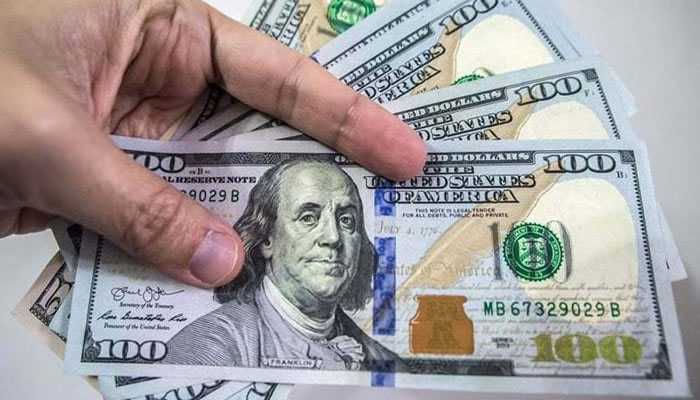Current account deficit shrinks 91pc in October as exports, remittances outpace imports
KARACHI: Pakistan’s current account deficit narrowed sharply in October from a year ago amid an improvement in exports and remittances as well as a decline in imports, the central bank data showed on Monday.
The current account deficit dropped to $74 million in October, which was 91 percent lower than a year ago. In October, the nation’s overall exports increased by 21 percent year-on-year to $2.762 billion, while its total imports fell by 7 percent to $4.346 billion. Pakistanis working abroad sent home $2.463 billion in remittances in October, a 10 percent rise.
On a month-on-month basis, however, the current account deficit increased by 61 percent in October compared to the previous month, mainly due to a wider trade gap caused by a surge in imports.
Even though October's deficit was higher than it was in September, analysts noted that this was the second consecutive month that the current account balance is almost at breakeven. The deficit was $46 million in September. In October, the country’s imports increased by 9 percent on a monthly basis. The volatility of international oil prices amid the Middle East conflict seemed to have led to a rise in Pakistan’s import bill. The slight increase in imports also reflects a recovery in the aggregate demand in the country’s economy.
The country’s goods exports rose by 12 percent and remittances increased by 12 percent month-on-month in October. Pakistan's current account deficit declined by 66 percent to $1.1 billion in the first four months (July-October) of the current fiscal year. This was mainly due to the government’s policy of keeping the trade deficit and, consequently, the current account deficit at a sustainable level in the face of low foreign exchange reserves.
Analysts predict that this fiscal year’s deficit would be manageable because planned foreign inflows were likely to materialise. According to economist and analyst Sana Tawfik of Arif Habib Limited, a brokerage firm based in Karachi, the current account deficit is expected to be around $4.1 billion in FY2024.
“Given that expected financing from bilateral and multilateral partners would support the nation's foreign exchange reserves, the deficit appears to be sustainable,” Tawfik said. “Furthermore, in the following months, it was expected that the government would stick to its policy of prioritising imports of necessities over all other goods, especially non-essential ones. It is unlikely that the government will fully permit imports of non-essential items until the reserves position improves.”
Last week, the International Monetary Fund staff and the Pakistani authorities reached a staff-level agreement on the first review under Pakistan’s stand-by arrangement (SBA) that was subject to approval by the IMF’s executive board.
Upon approval, the country is set to get approximately $700 million, bringing the total disbursements under the SBA to nearly $1.9 billion. As of November 10, Pakistan had $12.5 billion in foreign exchange reserves, up from $8.5 billion in May. It is projected that Pakistan will get approximately $1.2 billion in financing from the World Bank, Asian Development Bank, and Asian Infrastructure Investment Bank before the end of the year. The government also expects more inflows from Saudi Arabia and the United Arab Emirates to support the country’s economy.
-
 Prince Harry Relationship With King Charles 'not Straightforward,' Says Expert
Prince Harry Relationship With King Charles 'not Straightforward,' Says Expert -
 Truth Behind Jennifer Lopez's 'rude' Glambot Moment Laid Bare
Truth Behind Jennifer Lopez's 'rude' Glambot Moment Laid Bare -
 Nicole Richie Still Loves This Makeup Trend From Her Teen Years
Nicole Richie Still Loves This Makeup Trend From Her Teen Years -
 Meghan Markle Plans To Hide Behind Kids Over Return To UK
Meghan Markle Plans To Hide Behind Kids Over Return To UK -
 Dolly Parton Marks Major Milestone As State Governor Honors Her Legacy
Dolly Parton Marks Major Milestone As State Governor Honors Her Legacy -
 Karley Scott Collins Reacts To Rumours Of Her Dating Keith Urban
Karley Scott Collins Reacts To Rumours Of Her Dating Keith Urban -
 Meghan Markle Sends Shockwaves With Promise Of Chaos: ‘Has The Power To Upset The Royals’
Meghan Markle Sends Shockwaves With Promise Of Chaos: ‘Has The Power To Upset The Royals’ -
 Jesy Nelson, Zion Foster Call It Quits Amid Twins' Heartbreaking Diagnosis: Source
Jesy Nelson, Zion Foster Call It Quits Amid Twins' Heartbreaking Diagnosis: Source -
 What King Charles Told Princess Diana In Letter Before Wedding?
What King Charles Told Princess Diana In Letter Before Wedding? -
 David Crosby Said This One Singer Had 'no Talent At All'
David Crosby Said This One Singer Had 'no Talent At All' -
 Meghan Markle’s Return Risks Setting Off Something ‘exhausting’ And William, Kate Are Bracing
Meghan Markle’s Return Risks Setting Off Something ‘exhausting’ And William, Kate Are Bracing -
 Bruce Springsteen Reveals Singer He Finds To Be Greatest Rock And Roll Voice
Bruce Springsteen Reveals Singer He Finds To Be Greatest Rock And Roll Voice -
 Andrew Mountbatten Windsor Ensures Teddy Bear Collection Reaches New Home
Andrew Mountbatten Windsor Ensures Teddy Bear Collection Reaches New Home -
 Ben Affleck Recalls 'throwing Up' During 'Armageddon's Final Scene
Ben Affleck Recalls 'throwing Up' During 'Armageddon's Final Scene -
 Kevin Costner Marks 71st Birthday With Decades-old Throwback Photos
Kevin Costner Marks 71st Birthday With Decades-old Throwback Photos -
 Why Royal Lodge Fell Into Disarray Under Andrew: Insider Exposes Loophole
Why Royal Lodge Fell Into Disarray Under Andrew: Insider Exposes Loophole




